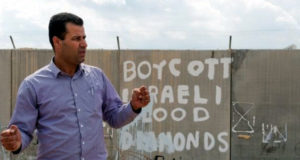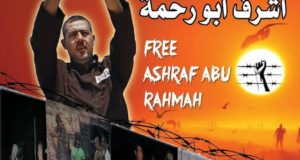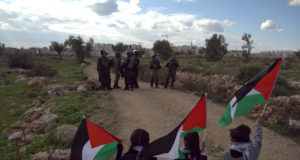by -bat.
I thought long and hard about how to write up this bit, because if I write it in the first person it becomes about me, and about one thing which happened to me once, but I want it to be about the people of this village who have this happen to them regularly, and have done so for a long while. But in the end the only way I know how to explain things is how I saw them.
Executive summary: last Friday I was on a peaceful demonstration which was tear gassed by Israeli troops before it had even reached the site of the intended protest. They then opened fire with rubberised steel bullets as people ran. I saw an ambulance worker shot in the stomach, I saw people gassed so badly they were stretched away, and I saw the troops firing on children. Israel may say that it doesn’t do these things. Israel is lying.
The village by the wall
If you wanted a suitably “biblical” looking postcard of the holy land then Bil’in would do nicely. Bathed in sunshine and sitting on a hilltop surrounded by olive-grove covered slopes it is a picturesque location, of maybe a thousand people I would guess. Whom, until recently, made their living from agriculture. Walking out to the west of the village, however, it becomes rapidly apparent that Bil’in has a problem.
When Israel decided a few years ago that it was going to wall in the entirety of the west bank, it also made a decision that it would take the opportunity to grab some land. hence the barrier does not run along the boarder, but instead sweeps east at various point to encircle various settlements, and thus also cut off large swathes of the countryside, leaving them the Israel side of the barrier. One such settlement group lies a few kilometres to the west of Bil’in, and thus the barrier has been driven right through the countryside a few hundred yards from the village, cutting the population off from their land completely. A whole towns livelihood wiped out virtually overnight.
This was the first place I saw the rural form of the barrier – and it looked so horribly familiar. As a young teenager I was taken by my parents to see the “iron curtain” at the point where it ran along the border between east and west Germany. This is identical – a cleared strip of land running across the hilltops as far as the eye can see in ether direction, with a fence along the length of it, and an access road behind where soldiers drive up and down to guard the structure. Beyond in the distance are the clean modern blocks of the settlements, and the cranes of the construction work as they are expanded onto the newly appropriated land.
The Friday demonstration
Since the construction of the barrier began the villagers have been protesting it every Friday by marching out of town to the site of the work. Even though the barrier is complete, these protests continue. After mid-day prayers a crowd forms in the village square and the walk out to the barrier commences. It is an enthusiastic atmosphere – the locals are joined by internationals like myself, and the protests have become themed to co-incide with other events in the west bank. This week was “prisoners week”, and as such some of the protesters had loosely bound their wrists to represent handcuffs, with a makeshift cage at the front in which a number of people march to represent a prison.
We walked out of the village centre in the sunshine, along the track which used to lead out to the farmland before the barrier. People are carrying posters and waving flags – there are no weapons. The road leads down a hill into a small valley, and up the far side to where the barrier is. There we could see a line of soldiers, in riot gear, with a water canon truck, and a second set positioned half way down the hill. The soldiers were the Palestinian side of the barrier, which puzzled me slightly, but I didn’t think anything of it. There were, after all, a very long way away as yet.
Rules of engagement
If you look up on the internet what Israel states as it’s policy for using force against demonstrations you will find that tear gas and percussion grenades are only to be used in the case of rioting or when Israeli forces are being directly threatened. The use of steel bullets coated in rubber is only to be used if this fails to break up the riot, and then the rounds are only to be targeted at individuals directly identified as being involved in attacking the forces. They are never to be fired at women or children.
Bear all that in mind will you… because when we got to the bottom of the hill – still simply walking along the road, and a good half a mile from the actual barrier, they opened fire on us with a volley of tear gas.
The trick is to keep breathing
My initial reaction was one of disbelief – I had been warned to expect gas at some point, and given a crash course briefing in how to deal with it – but I wasn’t expecting it then. When a gas round is fired it sounds like a firework and curves up into the air. Everyone freezes and watches it to try and work out where it will fall, and when it lands there is a second of working out where the cloud of smoke is heading in which you make a decision which way to run. Along with many other people I cut right into the olive groves, scrambling over the rocks. More gas started raining around us and we beat a retreat back up the hill towards the road. I was retching, and becoming confused. I could head more shots being fired, but looking to the sky I couldn’t see any rounds arcing over my head. I didn’t really think what might be happening at that point though.
We regrouped on the road up the hill, and dealt with some of the people who had caught the worst of the gas. I felt sick and red-eyed, but basically O.K., as I had managed to head upwind and not caught too much of a dose. After a while the demonstration regrouped and collectively everyone picked themselves up and started heading back down the road again towards the barrier for a second time. This time we didn’t even get to the bottom of the hill before they started firing on us. Once again I watched as two landed near me, chose a direction and ran… but this time I was not so lucky and one landed right at my feet enveloping me and the people I was with in a thick cloud.
Do you want to know what tear gas feels like ? It’s mis-named, as it may well make you cry, but the initial feeling is that it is burning your lungs out and you can’t breathe. It isn’t really a gas, and it contaminates anything it touches – it gets on your clothes and when it gets on your skin it burns that too. Very soon you are reduced to trying not to vomit and believing that you can’t breathe no matter how hard you try to. It’s horrible stuff, but we had counter measures. Half a raw onion in my inside pocket. odd as it may seem, if you try and breathe the onion vapour, the stinging sensation from it starts to open up your lungs, and the smell reminds you that you *can* breathe after all. How much is a real effect and how much is psychological I do not know, but it worked. I came out of it O.K. and found myself sitting gasping by the roadside halfway back up the hill. Others weren’t so lucky and they were bringing in an ambulance and stretchers to move out the worst casualties.
Freedom of the press
I didn’t mention at the start, but the demonstration also had a number of press people in attendance to record what was going on. A press reporter in Bil’in is easy to spot. There are giveaways – the dark blue flak jacket, the helmet and the gas mask for example. Whilst we run around facing the troops in t-shirts armed only with half a raw onion, these guys stand well back in body armour and gas masks making notes and taking pictures. It is quite surreal – but the press are there to observe, not take part, so you can’t begrudge them the protection. It does feel odd though.
I found myself next to a press man after the second encounter. He was trying to grab his cameraman and was chattering away in alarm on his mobile phone to someone, a conversation I was trying to overhear but couldn’t really understand. When he had finished I asked him what was going on. It turns out that the soldiers had arrested and taken away a journalist who had got too close to them in order to see what they were doing. To the best of my knowledge that journalist was the only person the Israeli’s detained that day on the demonstration. He was not taking part in the demonstration, he was merely there to report the facts. You can draw your own conclusions from that I guess.
Under fire
I mentioned earlier that I had been puzzled by the sound of weapons firing but no visible tear gas projectile overhead. By now I had realised what these were – rubber bullets. A rubber bullet is not actually made of rubber, it is made of steel and coated in rubber. People have been killed by them, and they can cause significant injuries. Martinez, Katie’s flatmate who took me to Bil’in, showed me the scar on the back of his leg from where he had been shot by one. Unpleasant things. The official line is that they are only ever fired at the legs of people, and only people actively involved in violent activity such as rioting or stone throwing.
By this point the demonstration had been broken up into a scattered mess of people spread across the hillside. Small pockets tried to get close to the fence at various points, and were repelled by the soldiers. I was at my limit for the amount of gas I could take, and had moved back up the hill to the village edge. This was where I started to realise quite how many casualties there were. People being moved past on stretchers, blood from wounds caused by the bullets, and ambulances from the Red Crescent moving in and out. These workers were highly distinctive, in the normal white red cross top with the red logo on them. They could not be mistaken for demonstrators in any way shape or form.
Which makes it all the more upsetting that around this time one of them was shot in the stomach. I am going to assume that even the Israeli’s would not deliberately fire at medical workers, but that leaves the only real explanation that they were firing indiscriminately into the crowd. The guy went down and was brought behind a ruined building to get him out of the line of fire.
Actually, I am not so sure that they wouldn’t fire on medical staff, as I did see them tear gas a group of medical personnel attending to a casualty on a stretcher on the ground. At least we could run when the gas comes in, but with a patient on the ground they couldn’t.
Heard enough yet? One more thing
I could go on, give you more details, talk about some of the stuff I saw, but it’s all more of the same. People getting gassed, people getting shot in various places (including Martinez, who managed to jump and deflect a bullet with his heel). At one point I came across a soldier I hadn’t seen just across the valley from me. Close enough for him to shout “hey you” at me in english, and then shoot. I’ve had a number of loaded weapons pointed at me over the years by members of authority. This is the only time anyone has ever pulled the trigger. It was “only” tear gas though, and with my onion clutched to my face like a magic talisman, I ran.
But there’s one more thing I need to say. There were a number of children from the village who would run past the adults and get far closer to the soldiers than anyone else and start flinging stones at them. Foolhardy or brave, up to you to decide, but we are talking small children here, not teenagers. Towards the end of the day when the demonstration had all but dissipated the kids were still running in and out of the olive trees, long after the adults had given up and gone to attend to the wounded.
I was sitting on a rock at this point, maybe five in the evening by this time, looking down at the scene, talking to one of the internationals and listening to the sound of the firing. I had got used to it by then, and it was a while before I began to wonder why they were still firing. Or, more to the point, what they were firing at. Looking down the slope gave me the answer, as far as I could make out they were firing at the children. I was watching a battle between fully equipped soldiers and nine year olds armed with stones, and the soldiers were firing back.
Like I said at the top, this was one afternoon for me, but for them it’s every week.
I think I’m done.
 International Solidarity Movement Nonviolence. Justice. Freedom.
International Solidarity Movement Nonviolence. Justice. Freedom.


